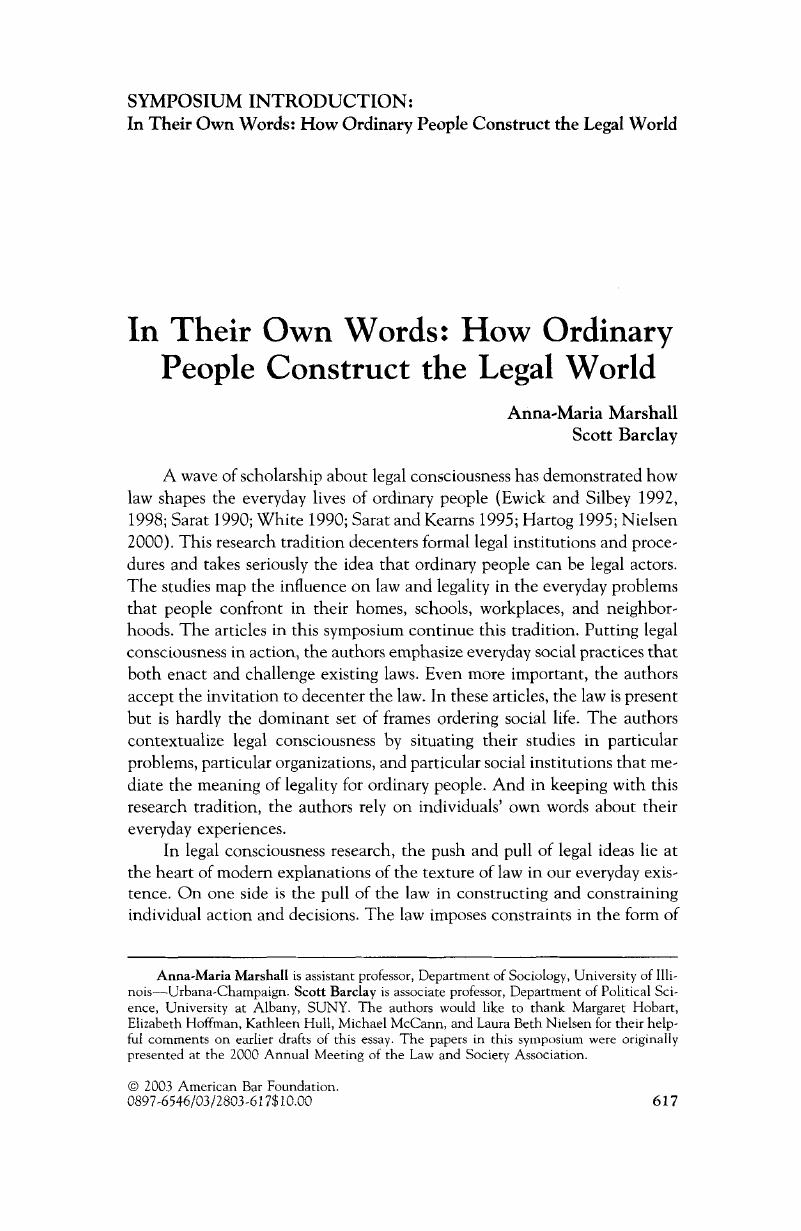Crossref Citations
This article has been cited by the following publications. This list is generated based on data provided by Crossref.
Wilson, Joshua C.
2004.
Vol. 35,
Issue. ,
p.
145.
Hoffmann, Elizabeth A.
2005.
Dispute Resolution in a Worker Cooperative: Formal Procedures and Procedural Justice.
Law & Society Review,
Vol. 39,
Issue. 1,
p.
51.
Marshall, Anna-Maria
2005.
Idle Rights: Employees' Rights Consciousness and the Construction of Sexual Harassment Policies.
Law & Society Review,
Vol. 39,
Issue. 1,
p.
83.
Gallagher, Mary E.
2006.
Mobilizing the Law in China: “Informed Disenchantment” and the Development of Legal Consciousness.
Law & Society Review,
Vol. 40,
Issue. 4,
p.
783.
Paris, Michael
2006.
The Politics of Rights: Then and Now.
Law & Social Inquiry,
Vol. 31,
Issue. 4,
p.
999.
Cormier, Kelley E.
2007.
Grievance Practices in Post-Soviet Kyrgyz Agriculture.
Law & Social Inquiry,
Vol. 32,
Issue. 2,
p.
435.
Goldberg-Hiller, Jonathan
2007.
Special Issue Law and Society Reconsidered.
Vol. 41,
Issue. ,
p.
83.
Saguy, Abigail C.
and
Stuart, Forrest
2008.
Culture and Law: Beyond a Paradigm of Cause and Effect.
The ANNALS of the American Academy of Political and Social Science,
Vol. 619,
Issue. 1,
p.
149.
Tinkler, Justine E.
2008.
“People Are Too Quick to Take Offense”: The Effects of Legal Information and Beliefs on Definitions of Sexual Harassment.
Law & Social Inquiry,
Vol. 33,
Issue. 2,
p.
417.
Hoffman, Bruce
2008.
Minding the Gap: Legal Ideals and Strategic Action in State Legislative Hearings.
Law & Social Inquiry,
Vol. 33,
Issue. 1,
p.
89.
Hoffmann, Elizabeth A.
2009.
Obscured Inequalities in Mechanisms for Managing Workplace Disputes.
Sociology Compass,
Vol. 3,
Issue. 3,
p.
491.
Blackstone, Amy
Uggen, Christopher
and
McLaughlin, Heather
2009.
Legal Consciousness and Responses to Sexual Harassment.
Law & Society Review,
Vol. 43,
Issue. 3,
p.
631.
Berti, Mario
2010.
Handcuffed Access: Homelessness and the Justice System.
Urban Geography,
Vol. 31,
Issue. 6,
p.
825.
He, Xin
Wang, Lungang
and
Su, Yang
2012.
Above the Roof, Beneath the Law: Perceived Justice Behind Disruptive Tactics of Migrant Wage Claimants in China.
SSRN Electronic Journal,
Lovell, George I.
2012.
Special Issue: The Legacy of Stuart Scheingold.
p.
1.
Blackstone, Amy
2013.
Ageism and Mistreatment of Older Workers.
p.
31.
Guzik, Keith
2013.
Taking Hold of the Wheel: Automobility, Social Order, and the Law in Mexico's Public Registry of Vehicles (REPUVE).
Law & Society Review,
Vol. 47,
Issue. 3,
p.
523.
Tinkler, Justine E.
2013.
How do sexual harassment policies shape gender beliefs? An exploration of the moderating effects of norm adherence and gender.
Social Science Research,
Vol. 42,
Issue. 5,
p.
1269.
He, Xin
Wang, Lungang
and
Su, Yang
2013.
Above the Roof, Beneath the Law: Perceived Justice behind Disruptive Tactics of Migrant Wage Claimants in China.
Law & Society Review,
Vol. 47,
Issue. 4,
p.
703.
Alexander, Samuel
2013.
Voluntary Simplicity and the Social Reconstruction of Law: Degrowth from the Grassroots Up.
Environmental Values,
Vol. 22,
Issue. 2,
p.
287.



